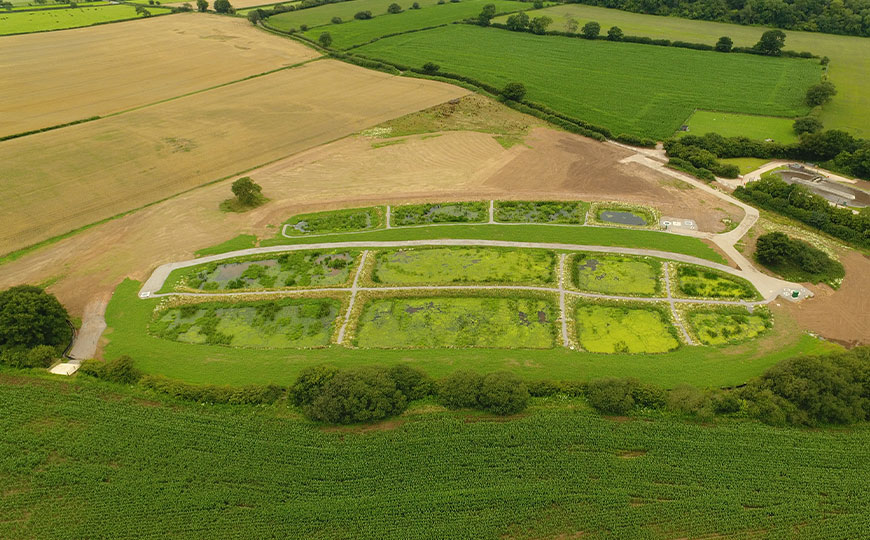Cromhall research reveals environmental benefits of wetlands
Constructed wetlands could successfully deliver a natural alternative to chemically treating wastewater before it is returned to the environment, according to the findings an investigation by Wessex Water on its pioneering site at Cromhall Water Recycling Centre.
- Findings from industry-first wetlands in South Gloucestershire could lead the way for wider water sector
- Nature-based alternative to chemical dosing proven to reduce phosphorus in treated wastewater released back into rivers
- Biodiversity value increase of more than 100 per cent set to continue over 30-year period
The wetland started operating last year as part of moves to ensure the water quality and ecology of the nearby Tortworth Brook was protected and enhanced.

The investigation into the effectiveness of the rural South Gloucestershire site – the first of its kind in the water industry designed to remove phosphorus from sewage effluent – assessed how the wetland removed nutrients, organic pollutants and chemicals and delivered biodiversity enhancement following its construction.
The findings revealed that such a wetland can keep the concentration of phosphorus in effluent within permitted limits, while further ongoing academic research demonstrates that the wetlands also help to effectively remove microplastics and more than 70 per cent of some compounds from the water, as well as reducing the bacteria being released into the environment by more than 95 per cent.
Ruth Barden, Director of Environmental Solutions at Wessex Water said: "Essentially, Cromhall is the first example of using a sustainable alternative to chemical dosing to achieve phosphorus reductions at sewage works and there has been a high level of interest as companies look to achieve net zero carbon and identify opportunities for wider environmental gains."
"As well as phosphorus removal, wetlands address other water quality parameters, such as bacterial reduction and their resistance to diseases and infections, as well as microplastics, which have implications for discharges to areas such as inland bathing waters."
The Cromhall investigation was included in the WINEP (Water Industry National Environment Programme), with its outcomes being reported to the Environment Agency at the end of March 2022.
This is part of Wessex Water's continued drive to deliver wider environmental benefits, including net zero carbon, biodiversity gains, improved river water quality and a reduction in flood risk.
The company is leading the way in researching how effective the introduction of nature-based solutions, like wetlands, are proving to be. The outcomes of this investigation will be closely monitored as water companies address their own environmental challenges as well as government guidance advocating using such measures to achieve water quality and wider environmental targets.
The investigation's findings
The analysis revealed the effectiveness of the wetland appeared to be at its greatest during summer months, with lower water flows, warmer temperatures, more daylight and significant macrophyte growth all contributing to the positive findings.
On average, annually the wetland reduced concentrations of phosphorus to within the proposed permit limit of three milligrammes of phosphorus per litre at Cromhall WRC, with the report concluding: "To allow nature-based solutions such as Cromhall ICW (Integrated Constructed Wetland) to become viable alternatives to 'traditional' treatment approaches, there needs to be acceptance that the performance will vary due to the natural processes involved."
Also among the findings on water quality were a 27.5 per cent reduction in total phosphorus as well as a 62 per cent reduction in ammonia and more than 60 per cent in nitrogen.
The investigation also determined a 111 per cent increase in biodiversity value, with the projected increase expected to continue significantly over a 30-year period.
"These findings will help to inform how the site should be managed going forward to ensure the best balance between water quality removal performance and biodiversity value," said Ruth Barden.
They also offer evidence towards our future investment decisions as we strive for a more sustainable approach towards improving water quality and local biodiversity of our water courses and achieve lower carbon and more cost-effective solutions for both sewage works discharges and storm overflows.
We hope that this report will inform government policy and the evidence base to enable more wetland solutions to be implemented in the future by all water companies, not just Wessex Water."
You can read an executive summary of Wessex Water's Cromhall Wetland Investigation report that was submitted to the Environment Agency here: Cromhall wetlands trial.
Summary of findings
| Water quality | Biodiversity |
|
|
